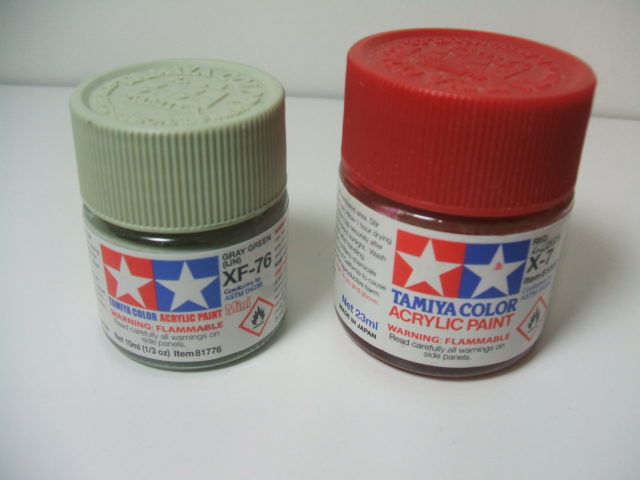
Zen and the Art of Model Painting
Paint has come a long way in the last century. The paint industry has created a radically different technology than existed a hundred or even fifty years ago. Today’s paints are less toxic, more durable, require less maintenance, look better and last longer than old-fashioned paints. Unfortunately, nothing new and better comes free of cost. New paints require new methods, and in some cases these methods are so radical and new that adopting them feels like starting over from scratch.
That’s how I felt twenty years ago, when I put down my airbrush and faced a blank wall. I admit that I was discouraged, at first. Blankness tends to feed back on itself, and I felt as hopeless as any other person when faced with the task of having to climb that faceless, unwelcoming, seemingly impossible blank wall. Fortunately, I had a secret weapon. Robert Pirsig.
I had read Pirsig’s two books, Zen and the Art of Motorcycle Maintenance and Lila, and I had the extraordinary wisdom of that chap to guide me as I felt my world spinning down into the basement floor drain as I sat at my workbench, wondering how to proceed. I recalled Pirsig’s description of the Indian Monkey Trap. A monkey has put his hand in the trap and grabbed a handful of rice. He can’t remove his hand until he lets go of the rice. He put his open hand easily through the bars to get the rice, but his fist won’t fit between the bars on the trap in order to remove it. But he’s not about to let go of that rice! So the villagers are approaching. He’s going to be caught. All he has to do is let go of the rice. Change his value patterns and let go.
I realized that I was caught in an Indian Monkey Trap of my own. My rigid thinking had convinced me that painting with a brush was “juvenile” and that it would not, and could not, work. I had a mind full of prejudices and pre-judgments. All I had to do to break out of that trap was to evaluate each and every one of my strongly held convictions. Did I actually “know” what I thought I did? The only way to know for sure would be to experiment in order to find the truth, and not be afraid to be proven wrong.
So, I asked myself if a “brushed on” coat of paint was really, truly the brush-marked mess that I thought it would be. I bought some Testors Model Master Acryl because it was available. I bought the Luftwaffe colors because I had a Bf-109E from the Battle of Britain to paint. So I decided that instead of just brushing it on the model and hoping for the best, I would do an experiment on some plastic parts from a kit that was simply not going to be built. A “throw away” kit. This was a breakthrough. I could do experiments. I could try out things. So I applied the paint, using different techniques, and allowed it to dry.
It was miracle. The paint did not show brush marks. I felt like Leif Erikson, standing upon the shore of a new world. “Uff Dah! Am I glad to have survived that disaster! As we say in Norway, WHEW! I wonder where I am?” So I painted that first little Messerschmitt, and the result wasn’t just encouraging, it represented a new way of thinking. I had to paint a straight line. I “knew” that I couldn’t paint a straight line because 1) I couldn’t do it when I was eight, and 2) “nobody” can do that.
Well, I turned out to be a big liar to myself. I could do it. I can paint straight lines just by trying to do so with a brush. I’m sure that some people truly cannot do this, but I believe that most of us can, we just don’t know it. The final result of my very first attempt to build a model without spraying paint or masking didn’t turn out badly at all. It wasn’t perfect, but the result was surprisingly good, compared to what I had expected. I still have that model. Here’s a photo of it.
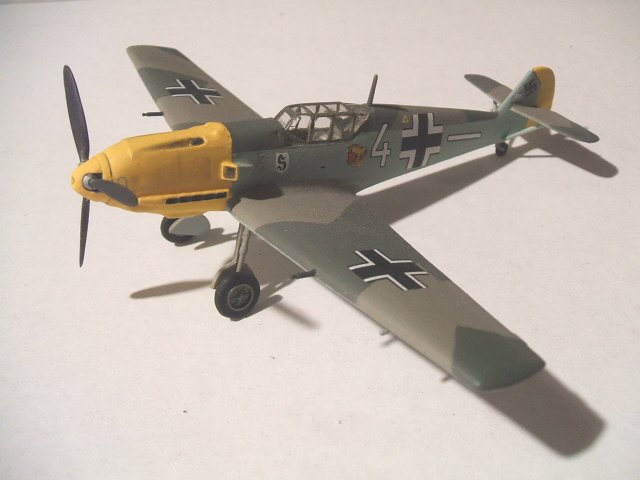
Now that I had learned to brush on Testors version of acrylic paint, I jumped to the conclusion that all modern paint would be equally good. I bought some Polly Scale paint, which turned out to be very, very similar to the Model Master Acryl paint. Then I bought some Tamiya paint, and discovered that not all modern acrylic paints are alike. Tamiya’s paint is very different from the Testors products I had been using. I didn’t notice it at the time, but I was uncovering a very real and very important part of my reinvented hobby–the search for my kind of paint. Not the search for “the best” paint–but for paint that I happened to like. Once again, I found out that my particular success or failure would depend upon my particular tools and methods, not something found in the latest book or website. I would have to find the answer for myself, sometimes finding parts of that answer in old publications and sometimes in the newest products.
Basically, I use a painting method I first learned about in 1969 from a magazine called Airspace Model. The article in question was entitled “Paint that Camouflage with a Brush” by a fellow named Ben Millspaugh in the March issue. Millspaugh explained that hobby paint like Humbrol Enamel could be brushed to an “airbrush” finish if you stop trying to use the brush to smooth the paint, and just use it to “dab” the paint on, so that adjoining “dabs” would flow together and, eventually, the wet paint would “self level” as it dried and create a perfect, smooth surface. This was a pretty radical idea to me then, and it remained a radical idea until I tried it (in desperation) with acrylic paint. It requires a paint be thinned so that it is “self leveling” but does not “bead up” on the plastic surface. Only certain paints have the required qualities. Humbrol enamel had them. Fortunately, I found that Testors Model Master Acryl had them, too. Since then, my knowledge and understanding of paint has grown considerably, but I still use the same basic method.
I have tested a number of the acrylic paints over the years. Since Polly Scale paint is no longer being produced, I’ll just refer to that type of paint as MM Acryl, since Testors two acrylic model paint lines have been merged into one (I know that isn’t exactly what happened, but I don’t think I want to rant about it right now). I mix MM Acryl and Polly Scale paint and they are, for my purposes, the same stuff. They both fit my methods. Without paint that works this way, my methods do not work. I need an acrylic paint that has certain characteristics. Fortunately, I’m not entirely dependent upon just one brand of paint, but the makers of paint hear loudest and longest from the spray-painting set, and it can be very difficult to know if a brand of paint will work for me or not. So I have to test them.
To save you the trouble of having to do the testing yourself, I’m going to provide a list of paints that work for me, paints that do not work, and paints that I can make work in a pinch. I don’t accept “close” as an outcome. A paint has to level itself out, period, or I don’t use it. My criteria for judging model paint has absolutely nothing to do with airbrushing. I may recommend a paint highly that can’t be airbrushed and I don’t care (how would I know?). I don’t use an airbrush for anything, or any other kind of spray-painting equipment, so why should I be interested in whether it dries on your tip? It’s irrelevant. So if anyone condemns a paint as “worthless” because it won’t spray, I’m inclined to want to try that paint out and see if it’s good for what I do.
Here’s a list of paints that work well for me, straight out of the bottle.
Testors Model Master Acryl (MM Acryl)
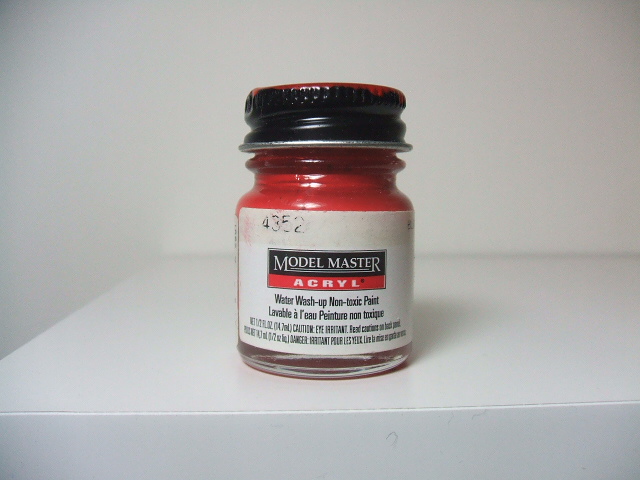
Grade: Excellent
This paint is widely available and easy to get in the U.S.A., but it difficult to get in the U.K. and some other countries.
Revell Aqua Color
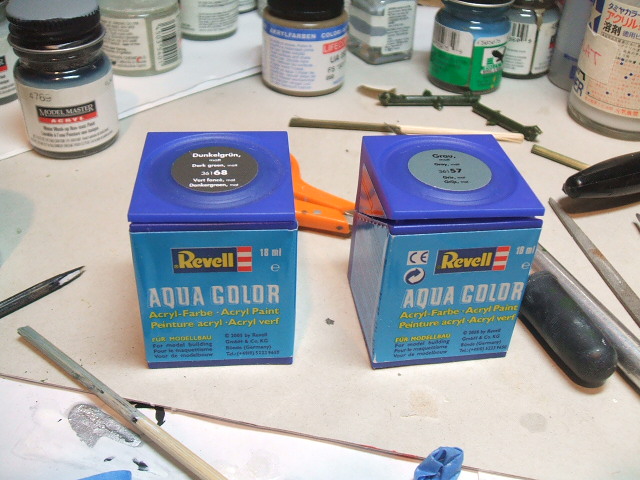
Grade: Excellent
Revell of Germany makes good paint but it’s not available in the U.S., unfortunately.
Xtracrylix
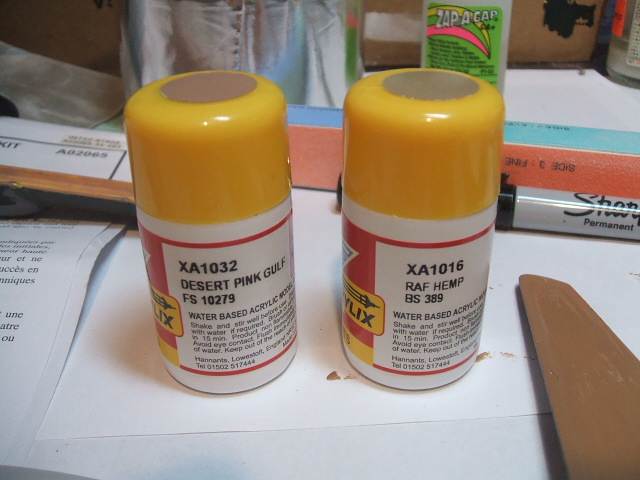
Grade: Excellent
Hannant’s of England makes paint that I can use, but the paint has a gloss finish that may not appeal to everybody. It’s also difficult to get, period, unless you order it from Hannant’s.
Here are paints that can be made to work with a few additives.
Tamiya Flat (Matt) Acrylic

Grade: Very Good
Tamiya makes excellent paint. You can spray it (I’m told) if you thin it with methyl-ethyl-ketone or some other hazardous substance that should not be sold to civilians. For my needs, I just add a few drops of “retarder” to keep it from drying so fast and I’m good to go. Better yet, I can thin it with a American window cleaner called “Windex” and it brushes beautifully.
Paints that work very well but require sophisticated technique:
Vallejo Metal Color
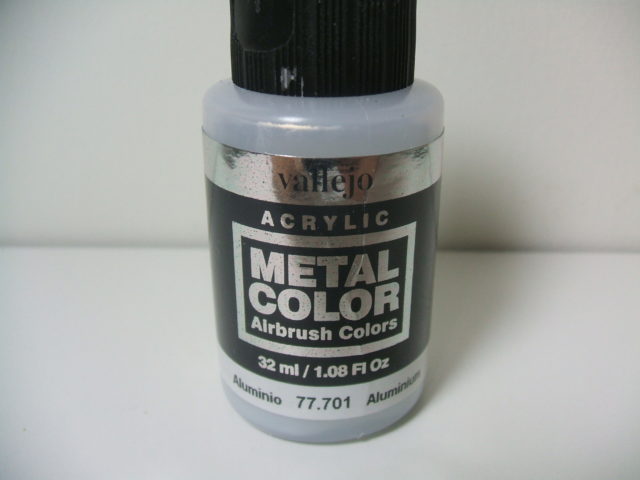
Grade: Excellent
This is a wonderful product. But the skill needed to apply it is something that has to be learned over time. Patience, Grasshopper.
Tamiya Gloss Acrylic
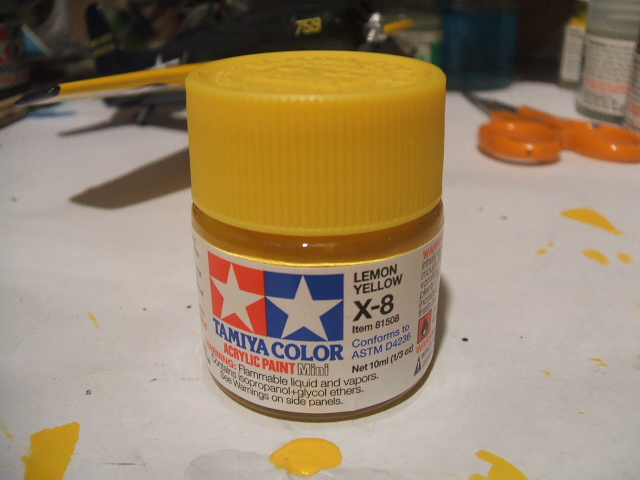
Grade: Excellent
Needs to be thinned with Windex. Can be brushed on if the painter can avoid brushing over the same spot more than once. It’s not as easy as it sounds, but after four coats the finish would work for a highly polished show car. Flawless.
Paints that work poorly.
Humbrol Acrylic
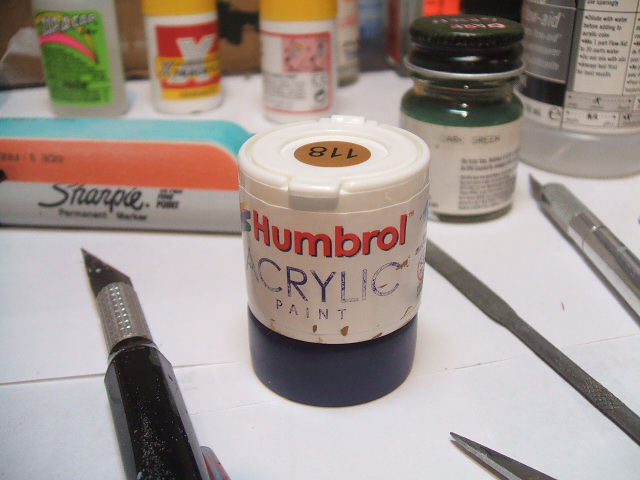
Grade: Fair to Poor
Brush marks. Poor adhesion. Looks bad using my methods. Others may get it to work but this isn’t their blog.
Lifecolor

Grade: Fair to Poor
Similar to Humbrol acrylic. Just doesn’t work for me.
Vallejo Model Color
Grade: Poor
(no photo–I threw this stuff out!)
Truly disappointing. It’s useful for painters who only brush paint tiny, tiny details on miniatures or instruments in model cockpits. For me, doing what I do, it does not work. No adhesion. Brush marks. Terrible packaging, too. I STIR my paint, never shake it, to avoid introducing air into the paint.
Popular paints that I haven’t tested yet.
Vallejo Model Air
Gunze Sangyo Acrylic
Vallejo Model Color — a trick I’ve found to make it work for brush painting a large surface area (only used on interiors so far) is to mix a drop of paint with a drop or two of Future. It thins it and makes it adhere well, with a rock hard finish once tried/cured.
I tend to work on my models daily, for just 1 hour. I make great progress on the projects I’m doing but don’t get burned out. IOW, waiting for a color to cure/fully dry is no big deal for me.
I haven’t tried that. It just might work because a similar treatment makes Humbrol acylic work better. My bad experience with Vallejo Model Color was right at the beginning of my “brush only” experiment, and I bought a lot of the paint, and was very deeply disappointed in it. Now, I have paint that works for me so I’ll stick to that. I get better results with the so-called “unbrushable” Tamiya than I ever could with the Vallejo product. But these things are highly individual in nature. There is no “right” way for everyone. Just a good way for each one to go independently. and I hope to provide some guidance– like the old man on the trail who says “don’t go into the volcano,” or “no swimming, crocodiles.”
Another trick for you is to have an undercoat of a more adhesive paint. I use two different undercoats when I am going to use the Humbrol acrylic or Vallejo MC; Humbrol enamel, or when avoiding fumes, Revell aqua. The Revell aqua sticks incredibly well, and is a perfect undercoat for when you need something for the weak paints to stick to. Perhaps you could use your Modelmaster in the same fashion? A nice light grey undercoat brushed on nice and thin.
Because I mix my own colors I can’t imagine needing to buy a low-adhesion paint. I know this is a concern for some model builders because they can’t get a certain color in their preferred brand, so they have to use something like Lifecolor or Vallejo Model Color, but if I need a color I’ll mix it myself from MM Acryl. I know that not everyone has good color vision (the only way my vision is good!) so this wouldn’t work for everybody, but mixing my own colors give me a lot of freedom.
No, no, my vision is fine. The scientific term for my problem is called ‘Laziness’. Not so much laziness of mixing colours, as laziness in getting a colour wheel, learning how to use it and know exactly what effect the added colours achieve. My lazy efforts of adding white or black to colours does not always have the desired result.
My modelling time is also very constricted. I am still at the ‘young children at home stage’ so between work, family and sleep, I might get a stolen hour here and there. Anything that helps me get to the fun parts of slathering the paints on the model is a good thing.
I just noticed the Gunze Sangyo at the bottom of your list. This paint is very similar to Tamiya acrylic (if you are talking about the Mr Hobby Aqueous. I am guessing you are not thinking about the Lacquer Mr Color which stinks worse than any enamel) and the pigment is, in my opinion, of an even finer grade, but the problems with brush painting remain the same. If I can steal your secrets for Tamiya, then I will happily be able to buy some Gunze which comes in a much greater range of military shades than Tamiya.
I actually left Gunze off the list for two reasons. I can’t buy it at any local hobby shop now (not sure why) and haven’t been able to for years. That’s reason one. Reason two is that I did have some problems, and they were serious enough for me to say “forget it.” The paint is wonderful to use and gives a great finish, but I could not find a clear coat that would work. Future changed the colors, and Polly Scale was so incompatible it actually “crazed.” I assume that to paint a clear coat over it you’d need to use the Gunze brand product for it to work. It was experiences like this that caused me to start doing “research and development” to avoid ruining a finished model at the last step.
After watching your excellent video on painting the MM Acryl, I have found a local source for it, now I just need to ask you a couple of questions; does it mix with Revell Aqua? and how long does it typically last in the bottle without drying out? If it does mix, then I will start snapping it up alongside my favourite acrylic paint.
I haven’t tried mixing it with Revell aqua because the two are just different enough to make me hesitate to do that. About shelf life: The MM Acryl will turn solid as a hockey puck if it’s stored incorrectly. Be aware that “fresh” bottles can go bad if stored on their side or upside down. I don’t know why exactly, but I think if the “solids” are exposed to oxygen they can react and turn into “rubber.” When you buy the paint, be aware of this and examine any that look odd. If a bottle has the “solid” on the side of the bottle instead of the bottom, then it was probably stored on its side and the pigment has turned hard. Once it cures, it won’t uncure. You can’t add solvent and fix it like you could with enamels. If you decide to buy a bottle and mix it with the Revell paint, I’d like to know the result.
Thanks for that. Since I will need to mail order them, I will take a chance, get a few test bottles and hope the trip doesn’t cause them to ‘spoil’. Once they arrive, I will decant some and try the mixing process, then let you know how it goes.
The Model Master Acryl has arrived, though due to work I won’t be attempting the mix for a day or two yet. However, after purchasing a few things from a local artists shop, I noted all of the various tubed acrylics by Liquitex, etc, and wondered how these would go on models. Have you tried mixing any of these up and applying them to the plastic?
Yes, I have experimented around with “artists” acrylics. I tried it straight from tube and got brushmarks and low adhesion. Really not usable. Then I mixed it with future and got a “glaze” that was translucent and interesting but not really usable. I stopped experimenting, but one of the things I’d like to do is experiment with making paint from “raw materials” i.e. pigment, acrylic medium, flattening agent, etc. I haven’t gotten around to doing that I don’t know if I will, but how hard can it be? I know that some modelers use “cheap” acrylic paint from Hobby Lobby or something like that. I tried some of it and got the usual problems– low adhesion and brushmarks. So that paint was “off the table” so to speak. By the way–use only water for thinning the MM Acryl, and use distilled water if you can. Using tap water can be “iffy.” Don’t put alcohol in MM Acryl or any similar paint. Keep in mind that I’m talking about thinning the paint right in the bottle. Airbrushing has a whole different paradigm. “Take the paint out of the bottle and thin it, do not return the thinned paint to the bottle.” That’s all “airbrush stuff” in my opinion. In fact, I routinely add water to a bottle of MM Acryl if it’s a little to thick. Also, I’m prejudices against shaking the paint. The MM Acryl seems to work better when stirred, not shaken. Tamiya too. What applies to martinis does not apply to paint.
I, too, also only stir my paints, never shake. Even the evil Vallejo Model Colors have the top taken out and stirrer used.
I also add a little demineralised water to my paints to keep them going, but usually transfer paint for heavy thinning if required. So far, the MM Acryl is quite thin and doesn’t need a lot of thinning (like Revell for eg), and I have to get used to brushing it. It goes on slightly different to the Revell, so I have had a few runs happening. But the adhesion when dry…excellent. Even on a smooth plastic spoon that I use as my colour samples, it stuck to that like nothing else.
It is different to the Revell, but I will still try a mix and see how we go.
Well, the Revell/MM mix does work, but separates quickly, so it should only be a ‘spur of the moment’ mix as I wouldn’t want to keep them in the same bottle. So, ‘usable’ is the verdict, with the above caveat.
Now, since my usual supply of Revell aqua is drying up (I have to order it from the UK, and lately they have been sending me substitutes when they run out, and those substitutes have been Vallejo model color. I am not happy). So I have been getting my sources for MM Acryl lined up. There are a few in Aus, so that is something.
Just a few questions about a few things I have read online. I keep reading about Pollyscale and how much better it was than MM Acryl, and that an earlier iteration, PollyS, was ten times better than either. What are the diffs between the paint Dan? And did you ever try this mystical ‘PollyS’? I have read Shep Paine carrying on about how awesome it was for brush painting in his old books from the 80’s, and since he had easy access to the old Humbrol and Model Master enamels, this PollyS must have been God Like for brush painting.
I did use Polly S and it wasn’t very good for anything. It’s like comparing an old VW bug with a new VW. Sure, some folks remember the old beetles with affection–but still. Polly Scale was very good. Mainly, though, it was the color selection that I liked. The colors “looked good” to me. MM Acryl (during the heyday of the 1990-2008 plastic kit boom) seemed to have been under the control of a color expert–in other words the colors were lightened for “scale effect” and matched to the “expert’s” chosen references (which fit into the “magical realism” genre). But the paint itself was good–very much like Polly Scale–except for coverage that was “slightly less good.” I don’t know how to say it except to explain that sometimes Polly Scale just flowed on like one of those dudes fishing for trout in “A River Runs Through It.” We’ll no see its like again in our lifetime, laddy. Anyway, if you want to pine for the perfect paint, pine for the near-legendary Aeromaster. That was paint made personally by Merlin somewhere in the misty forests of memory (I’m told)… never tried it.